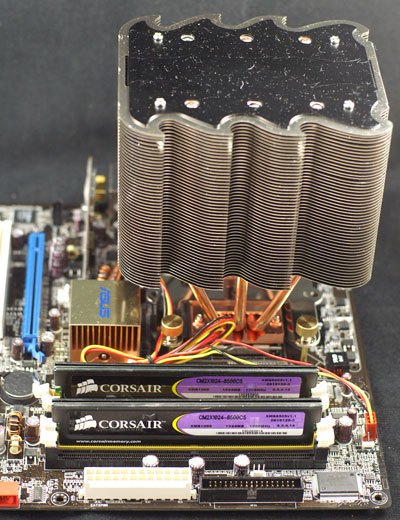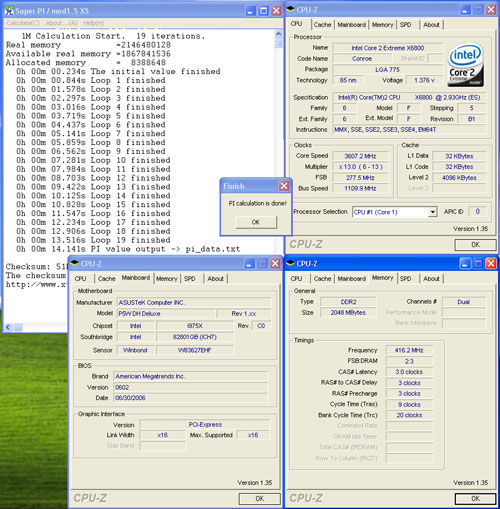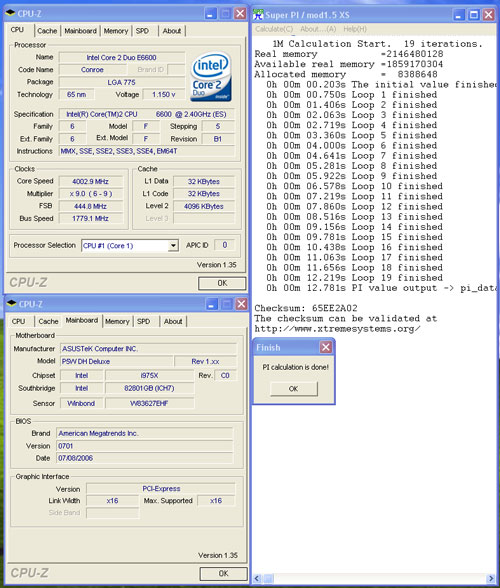Intel's Core 2 Extreme & Core 2 Duo: The Empire Strikes Back
by Anand Lal Shimpi on July 14, 2006 12:00 AM EST- Posted in
- CPUs
Overclocking
You have already seen that the Core 2 Extreme X6800 outperforms AMD's fastest processor, the FX-62, by a wide margin. This is exacerbated by the fact that the $316 E6600, running at 2.4GHz, outperforms the FX-62 in almost every benchmark we ran. That certainly address the questions of raw performance and value.
For most enthusiasts, however, there is also the important question of how Core 2 processors overclock. As AMD has moved closer to the 90nm wall, recent AM2 processors do not have much headroom. A prime example is the FX-62, which is rated at 2.8GHz, reaches 3GHz with ease, but then has a difficult time reaching or passing 3.1GHz on air. So how does Core 2, built at 65nm, compare in overclocking?
The top X6800 is rated to run at 11X multiplier on a 1066MHz FSB; it is the only Core 2, however, that is completely unlocked, both up and down. You can adjust multipliers up to 60 on the Asus P5W-DH motherboard, or down to 6. This makes the X6800 an ideal CPU for overclocking, even though top-line processors are normally notorious for not being the best overclockers.
To gauge the overhead or overclocking abilities of the X6800 in the simplest terms, the CPU speed was increased, keeping the CPU voltage at the default setting of 1.20V.
At default voltage the X6800 reached a stable 3.6GHz (13 x277). This is a 23% overclock from the stock 2.93GHz speed at stock voltage. It is also an important overclocking result, since it implies Intel could easily release a 3.46GHz or 3.6GHz Core 2 processor tomorrow if they chose to. It is clear there is no need for these faster Core 2s yet, but it does illustrate the speed range possible with the current Core 2 Duo architecture.
The X6800 was then pushed to the highest CPU speed we could achieve with Air Cooling. We did use a very popular and effective air cooler for our testing, the Tuniq Tower.

The goal was to reach the highest possible speed that was benchmark stable. Super Pi, 3DMarks, and several game benchmarks were run to test stability. The 2.93GHz chip reached 4.0GHz on air cooling in these overclocking tests. That represents a 36% overclock on air with what will likely be the least overclockable Core 2 processor - the top line X6800.
To provide some idea of overclocking abilities with other Core 2 Duo processors, we ran quick tests with E6700 (2.67GHz), and E6600 (2.4GHz). The test E6700 reached a stable 3.4GHz at default voltage and topped out at 3.9GHz with the Tuniq Cooler. The 2.4GHz E6600 turned out to be quite an overclocker in our tests. Even though it was hard-locked at a 9 multiplier it reached an amazing 4GHz in the overclocking tests. That represents a 67% overclock.
We had another Core 2 Extreme X6800 that we tried overclocking with a stock Intel HSF. The results were not as impressive as with the Tuniq cooler, with 3.4GHz being the most stable we could get it. We're going to be playing around with these processors more in the future to hopefully get a better overall characterization of what you can expect.
Curious about our overclocking successes, we asked Intel why Core 2 CPUs are able to overclock close to the same levels as NetBurst processors can, despite having less than half the pipeline length. Intel gave us the following explanation:
NetBurst microarchitecture is constrained by physical power / thermal limitations long before the constraint of pipeline stages comes into play. The microarchitecture itself would continue to scale upwards if not for the power constraints. (In fact, we have seen Presler overclocked to 6 GHz in liquid nitrogen environments. At that level, power delivery through the power supply & board itself begin to limit further scaling of the processor.)
Intel's explanation makes a great deal of sense, especially when you remember the original claims that NetBurst was supposed to be good for between 5GHz - 10GHz. NetBurst never got the chance to reach its true overclocking prime as Intel hit thermal density walls well before the 5GHz - 10GHz range and thus Intel's Core architecture was born. Intel's Core 2 processors once again give us an example of the good ol' days of Intel overclocking, where moving to a smaller manufacturing process meant we'd have some highly overclockable chips on our hands. With NetBurst dead and buried, the golden age of overclocking is back.
Enthusuasts have not seen overclocking like this since Socket 478 days, and in fact Core 2 may be even better. The 2.4GHz E6600, which outperformed the FX-62 in most benchmarks at stock speed costs $316, and overclocked to 4Ghz with excellent air cooling. With that kind of performance, value, and overclocking the E6600 will likely become the preferred chip for serious overclockers - particularly those that are looking for champagne performance on a smaller budget.
It is important, however, not to sell the advantages of the X6800 short. AnandTech never recommends the fastest chip you can buy as a good value choice, but X6800 does bring some advantages to the table. It is the only Conroe that is completely unlocked. This allows settings like 266(stock FSB)x15 for 4.0GHz, settings that keep other components in the system at stock speed. This can only be achieved with the X6800 - other Core 2 Duo chips are hard-locked - and for some that feature will justify buying an X6800 at $999. For the rest of us overclockers E6600 is shaping up to be the chip to buy for overclocking.












202 Comments
View All Comments
Calin - Friday, July 14, 2006 - link
A very good part of what Intel makes (processor wise) goes to mainstream and lower-than-mainstream performance (Celeron-like chips). There might be, in the end (of the year), enough production of Core2 to fill the enthusiast/retail market.Indeed, the Netburst are obsolete over night...
xFlankerx - Friday, July 14, 2006 - link
Not just Netburst, even the Athlon 64s are obsolete now.With the Pentium 4 vs. Athlon 64 debate, atleast there were moments when going with the Pentium 4 could be justified. However, because of the huge difference in performance and prices of the Core 2 Duo and Athlon 64 processors, I think it would be foolish to go for a new Athlon 64 system right now (unless ofcourse you're on a tight budget).
Calin - Friday, July 14, 2006 - link
Yes, Pentium4 was better in so-called media benchmarks, and there were some uber-optimized application that were flying on Pentium4.Right now, there are (as stated in article) three competitors: Core2Duo at high price, performance and low power, Athlon64 X2 at lower price, performance and a bit higher power, and PentiumD at dumping prices, even lower performance and quite a bit higher power. It all depends on how much money you would invest.
I am thinking at a single core Core2, and integrated video mainboard with ATI or NVidia chipset - or a Sempron AM2 3000+. I wonder how cheap a Core2 Solo would be
Squidward - Friday, July 14, 2006 - link
Agreed, an excellent review, I loved Anand's anologies about the dinner table. I get the feeling he may have been thinking Arby's (tm) when he wrote this review. :)My goodness does Intel's new lineup impress. I've been using AMD ever since the K6/2 days and was planning on getting an X2 soon, but this review has made me decide to wait it out just a little bit longer.
Great article guys, keep up the good work.
Viditor - Friday, July 14, 2006 - link
I'd say that the A64 X2s are still quite competitive, depending on your budget and availability of the C2Ds.
That said, Intel has done a magnificent job with these chips!
It looks like Conroe will own the high end market until AMD can release K8L...but judging by the review, AMD will own the low end. I can't see anyone buying a PD once AMD drops the prices, nor can I see anyone buying an AMD if they can afford a medium or higher priced system.
jkostans - Friday, July 14, 2006 - link
With the 1.83GHz conroe at $183 and on par with a X2 4600, I don't see the low end going for AMD either.Ultra low end will be a toss up however.Viditor - Saturday, July 15, 2006 - link
If you look at the situation in total, it will probably make more sense...
1. The X2 has far more inexpensive but fully functional motherboards to choose from.
2. Supply will be far more constrained on the Conroe than on the X2
Combos are king in the low end...for example, if you combine an Asus M2NPV-VM with an AM2 X2 3800 (after the price drop), you get a good dual core system with Raid 5, HDTV, nVidia 6150 graphics, Firewire, dual screen (VGA and DVI), and just about every whistle and bell you could want for (est) ~$250. You'd be hard pressed to find just a Conroe-ready motherboard with that kind of functionality for that kind of money (let alone a combo).
duploxxx - Friday, July 14, 2006 - link
correct the real performance king will be for now the conroe starting from 6600 and above. maybe 6400 this will be clear later. but for the budget platform it will be better to buy an x2 3800 or 4200 seeing the price combo it will have. mobo + proc is way cheaper then any intel combo (100$ and more) thats a lot for a budget system.duploxxx - Friday, July 14, 2006 - link
oh and one big item which is left out of sighht... the performance gain is less on a conroe then on a k8.. its a difference of 15% in identical apps... that's an interesting point for the future... just my opinionXenoid - Friday, July 14, 2006 - link
Yes it was a very, very well done review and I will definitely be purchasing one of these bad boys.